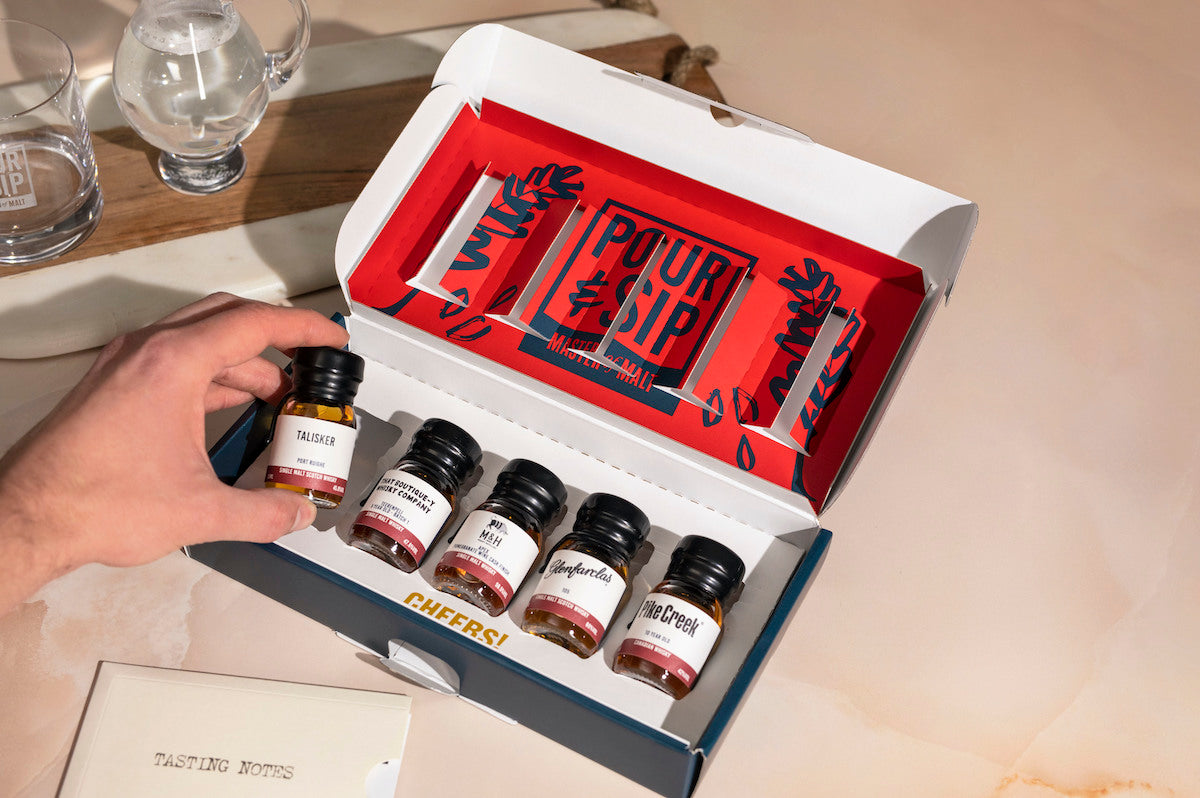April's Pour & Sip box has arrived!

We know we say it every month, but wow April’s selection of whiskies is truly taking us around the globe! From the Isle of Skye and the Scottish Highlands, to Canada, Finland, and Israel, with a plethora of cask types in here to enjoy too. Well, what are we waiting for? Let’s find out what they are.
Milk & Honey Apex - Pomegranate Wine Cask Finish
The Apex series from the Milk & Honey distillery in Tel Aviv is all about innovation and exceptional casks – as such, this whisky was initially matured in ex-bourbon casks before a six-month finishing period in casks which previously held Israeli pomegranate wine! Israel is lucky enough to see an average of 300 sunny days a year, so the hot climate maturation means that its whisky need not be aged for too long before you can see the effects of the wood and previous contents of the cask. Though this is a no-age statement expression, all whiskies from Milk & Honey are aged for a minimum of three years. Those familiar juicy and tangy flavours we know and love from pomegranates are right here in the whisky, along with a symphony of creamy sweetness, gentle spices, and oak influence.
Glenfarclas 105
A magnificent cask strength whisky from the Scottish Highlands, Glenfarclas 105 was first released all the way back in 1968, though not under its name today. At that time, Glenfarclas was the first distillery to release a cask strength single malt, whereas nowadays it’s much more common. Its name, 105, refers to its alcohol content in British Proof, which equates to 60% ABV. Though Glenfarclas is well-known for its sherry-matured whiskies, this one was aged in a combination of both ex-sherry and ex-bourbon casks. Given that it’s bottled at a burly 60% don’t be afraid to add a splash of water to help it open up a bit, as recommended by George Grant himself, the 6th generation of the family behind Glenfarclas.
Talisker Port Ruighe
From Scotland’s stunning Isle of Skye comes this rich, oily Talisker single malt. The distillery was built back in 1830, and Port Ruighe (pronounced 'Portree') is named after the Gaelic spelling of the once bustling trading port on the island, as well as a nod to the Scottish traders who braved the high seas and were instrumental in the foundation of the port wine trade. As such, after a maturation in a combination of ex-bourbon, refill European oak, and heavily-charred casks, this single malt was appropriately finished in ex-Port casks. That hallmark oily, maritime smokiness from Talisker is paired with subtly floral flavours and heaps of red fruit, as you’d expect from the fortified wine.
Teerenpeli 5 Year Old (That Boutique-y Whisky Company)
This single malt comes from Lahti, Finland, and was released for That Boutique-y Whisky Company's Wine Cask Series, having been aged in Spanish ex-Oloroso sherry casks for five years. But this wasn’t stored in any regular warehouse – the casks spend their days in 40-foot ex-reefer sea containers, which sit outside the distillery. The temperatures go through some crazy fluctuations throughout the year, from -35°C to +30°C, accelerating the contraction and expansion of the casks. It’s not just a family-owned distillery, but also claims that it’s the biggest distillery in Finland producing single malt whiskies. Oh, and the word ‘Teerenpeli’ translates as both ‘flirtation’ and ‘black grouse’, so you can pick your favourite!
Pike Creek 10 Year Old
An intriguing Canadian whisky here, Pike Creek 10 Year Old has been finished in ex-rum barrels! While Canada is well-known for rye whisky and there is a good proportion of rye in the Pike Creek mash bill, this is actually a blended whisky, with some corn in there as well. It’s initially aged in American oak ex-bourbon casks before being treated to its tropical finish – Pike Creek founder Don Livermore lays claim to a PhD in Wood Science, so you can imagine that he knows what he’s doing when it comes to casks. The warehouses are based in the neighbourhood of Pike Creek without any climate control. With freezing sub-zero winters and scorching summers, that means the barrels see a lot of temperature fluctuation throughout the year, boosting the interaction between the spirit and the oak. The result is a rich, flavourful, and distinctive whisky.



